Violet Spring Rose: breeding methods and care tips
Violet Spring Rose is distinguished by its greenish color of buds and flowers. Its delicate petals have an original shape. The plant is unpretentious in care, but needs to be kept in watering regime.
Content:
- Description of the variety
- Violet breeding methods
- Propagation by cuttings in water
- Propagation by cuttings in the substrate
- Violet transplant
- Violet Spring Rose Care
- Diseases and pests
Description of the variety
Violet Spring Rose bred by breeder Paul Sorano. It is decoratively blooming Saintpaulia with small white flowers, shaped like roses. Each of them consists of a large number of delicate petals, along the edge of which there is a green border.
The edge of the petal is serrated. In the process of flowering, the green color becomes weak, and then completely disappears. The buds remain green until blooming. The size of an open flower is 3-4 cm. The peduncle is short. Flowers stay on it for a long time.
Blooms profusely and for a long time, from May to November.
Leaves above are light green, wavy. On both sides, they are covered with thick fine hairs. The bottom of the sheet is lighter. The lower leaves lean down, touching the edge of the flowerpot. Root system located in the upper layers of the soil, grows rapidly.
Violet breeding methods
It is better to propagate Saintpaulia in spring, from March to April. Violet Spring Rose reproduces:
- Leafy cuttings
- By dividing the bush
- Stepchildren
- Peduncles
- Seeds
Propagation by leaf cuttings is the most popular method. If carried out in water, it is possible to control the course of root formation through the walls of a transparent dish or by taking out the stalk. But rooting in the substrate is faster, and the percentage of successful attempts increases significantly.
It is easy and quick to propagate by dividing the bush, but this is not always possible. To do this, you need to have an adult bush. Reproduction by peduncles is practically not used, because it is more difficult, and the varietal characteristics of Spring Rose are well transmitted through cuttings by leaves. It makes sense to propagate by seeds only if you need to cross Spring Rose with violet a different kind.
Propagation by cuttings in water
In order to get a young plant, it is enough to have only one violet leaf. For cuttings to succeed, it must be plucked from a healthy adult plant. Do not use old yellowed leaves. They don't have enough nutrients. Young people growing inside the outlet are also not taken. You need to take a strong sheet from the second or third row without scratches, burns, rot, not damaged or dried out.
Breeding features:
- The leaf is broken off from the bush so as not to damage it. The optimal leg length is 4 cm. It is cut obliquely with a sharp knife or razor. Pruning shears and scissors are not used, because they pinch the cutting and break the structure of its fibers. Some growers make a small longitudinal cut at the base of the leg. The wound area will serve as a place for root formation, so the larger it is, the better.
- If the stem is too long, the leaf will bend and fall off as it germinates. Therefore, it will have to be propped up in a pot.If it is short, the edge of the leaf may fall into the water or dry out if the water evaporates. This will be more difficult to track.
- To disinfect the stalk, immerse it in a weak solution of potassium permanganate, let it dry. You can germinate in water or in a substrate.
- For germination in water, do not take crystal dishes. If you place the handle in a bottle with a narrow neck, the leaf plate will not touch the water and will not rot. Each leaf is germinated in a separate bottle.
- Use boiled or settled water at room temperature. An activated tablet or a piece of crushed charcoal is dissolved in it. Set the handle so that its leg is immersed in water by 1 cm. Cover the dishes with a sheet with a transparent bag, in which several holes are made for ventilation. Set in a warm place so that the leaf is light, but the sun's rays do not fall on its plate.
- The water in the germination vessel is not changed. If it has evaporated and the stem of the leaf may be dry, add a little fresh water.
The first roots will appear on the handle in a couple of weeks. A rotten leg can prevent this. If this happens, take the stalk out of the water, cut off the entire unusable part. Sprinkle the place of the cut wood ash or crushed coal. Dry for half an hour. In this case, the water in the dishes must be completely changed.
Cuttings should be planted in pots with a substrate after the length of the roots reaches 1 cm.
The dishes must have holes for water drainage. It is convenient to use plastic cups. The drainage layer is prepared from expanded clay, foam is added to the loose soil. The cutting is immersed one and a half centimeters into the hole in the soil so that the roots do not break off.
Sprinkle with earth without ramming. The sheet is propped up with a stick or a match. Cover with a bag again and set for germination. Water only after the top layer dries. In a few weeks, babies should appear near the cutting. When small bushes grow up a little, they are planted.
Propagation by cuttings in the substrate
So that the cuttings do not rot, take root faster, and there are more children, the leaves are rooted in the soil. It is specially prepared by mixing vermiculite and perlite. The first increases the air permeability of the soil, the second makes it loose. Styrofoam can be added, sphagnum moss, nutritious soil.
Prepare the stalk as for growing in water.
Place it in a mixture with a warm, moist substrate. Seal and support to prevent it from falling. Do not water. Cover with a bag and set for germination. The leaf may lose its elasticity, but after a while the turgor will recover.
Water a little, once a week. Do not fertilize to stimulate root growth. The plants are ventilated twice a week for 10 minutes. After a month, the plant can live without shelter.
Violet transplant
Transplanted violet once a year, in spring, summer or early fall. But signs that it's time to do it are:
- The presence of white bloom on the soil in the pot.
- Roots protrude from the drainage holes.
- The plant does not bloom, is elongated, looks weakened.
- If you urgently need to transplant blooming Saintpaulia, all the buds and flowers are plucked.
Transplanting can be with full, partial soil replacement or transshipment. It is carried out if the roots of the plant are healthy. In order for the Spring Rose violet roots to draw moisture from the pan, the soil in the pot must be nutritious, loose and permeable to moisture. Take 5 parts of black soil, 3 parts of peat and part of sand. Add some sphagnum moss and charcoal, which will protect the roots from rotting. Lay the drainage layer at a third of the height of the new dishes.
The pot should be low, the diameter is a couple of centimeters larger than the previous one.
If it has been used before, clean and wash it thoroughly. Moisturize the soil in which the flower grows. Carefully remove it from the flowerpot. Trim the roots lightly, remove the lower old leaves.Place in a new pot so that the leaves touch the edge of the pot.
Fill in the remaining space with prepared soil. Do not watered after transplantation. In a day, they look to see if there is no need to add land if she is seated. Then watered.
Violet Spring Rose Care
Spring Rose variety is unpretentious in care. Saintpaulias don't like being heavily patronized. They are more likely to experience a lack of attention than an excess of it. Set the Spring Rose violet pot on the windowsill, not leaning against the cold glass. East or west windows will do. On the southern saintpaulias, you need to shade from direct sunlight.
Indoor flower care tips:
- The temperature for Spring Rose in summer is about 22 ° C, in winter it is desirable to lower it to 18 ° C. Violets do not tolerate drafts well. Therefore, they need to be installed where they are not. But the plant needs fresh air, so the room needs to be ventilated.
- Some growers supplement the lighting in winter phytolamps, bringing daylight hours to 16 hours. But even without this, the violet Spring Rose will survive the winter well.
- The main thing is not to water the Saintpaulia too often. From this, the roots of the plant can rot. As a result, the violet may disappear. In winter, an adult Spring Rose violet is watered in a tray 2 times a week. Small expanded clay, pebbles or sand are laid on its bottom. Pour water and place the pot on the tray. In summer, during the flowering period, you can water every day, but only when the soil dries out. Violet Spring Rose leaves are not sprayed, especially during the flowering period. They are covered with thick hairs, so moisture will collect on them, which can lead to leaf rot.
- Violet Spring Rose responds well to feeding mineral and organic fertilizers, which alternate depending on the season. In winter, organic matter is introduced once. In spring and autumn, they are fed with special mineral fertilizers for violets, bought at a flower shop, 3 times per season. In summer, organic matter is introduced if the plant is weakened or weakly blooms.
Diseases and pests
Painful conditions violets associated with a violation of the care regimen. If the soil is heavy gardening, it grows poorly. Moisture stagnates in the roots. This also happens with excessive watering, growing in a deep pot, and poor drainage.
If the soil is acidic, the edges of the leaves turn yellow. Pour with an aqueous solution of dolomite flour. If the soil is alkaline, the leaves do not grow and turn pale. Watering with a small amount of vinegar can correct the situation.
Violation of the temperature regime and frequent watering can lead to fungal diseases:
- Powdery mildew
- Late blight
- Fusarium
- Gray rot
It is worth fighting the disease if it has captured small areas. Remove the affected areas, process fungicides, are transplanted into uninfected soil. Otherwise, the plant is thrown away. The surviving leaves after disinfection can be used for reproduction.
Mealybugs, crawling insects, covered with a white bloom, bite through the leaves, leaving ugly reddish spots. The leaves are deformed, the flower loses its decorative effect. You can get rid of them by treating the plant with Fitoverm or Aktara. The same drugs are used to kill thrips and aphids. Aphids suck the juice from the stems and peduncles, as a result they die. You can fight a small amount of aphids with a solution of laundry soap.
More information can be found in the video:



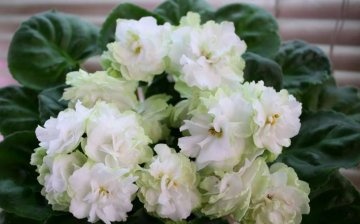
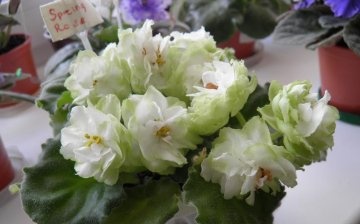
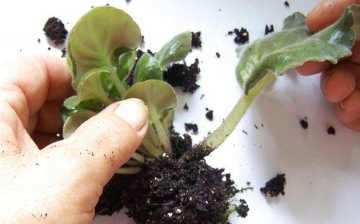
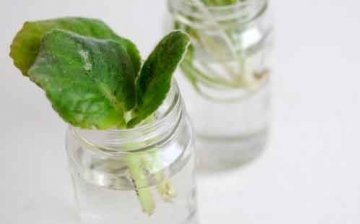
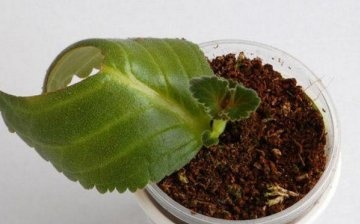
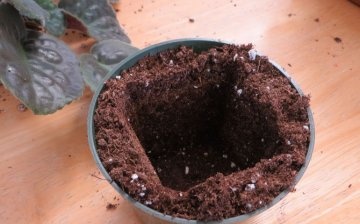
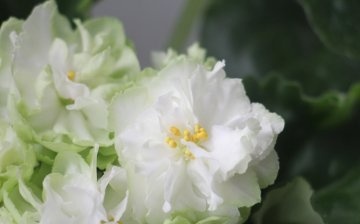
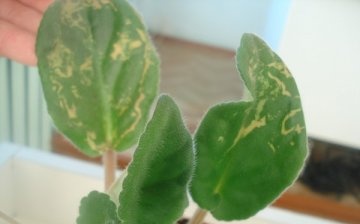









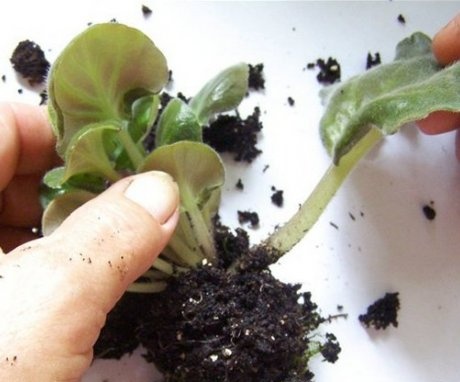
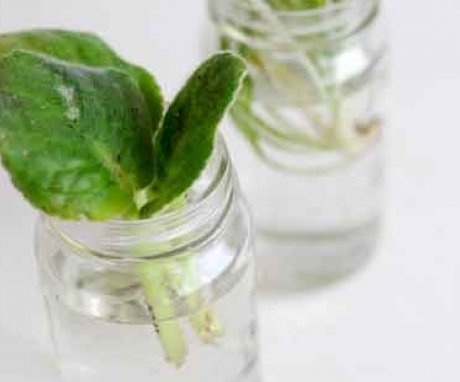
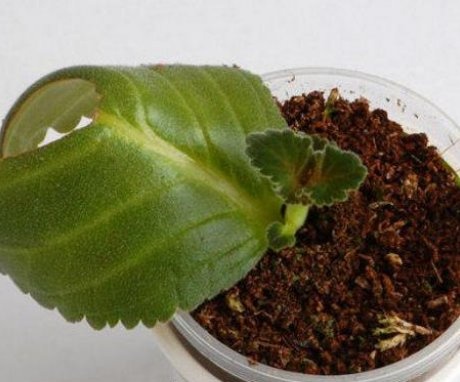
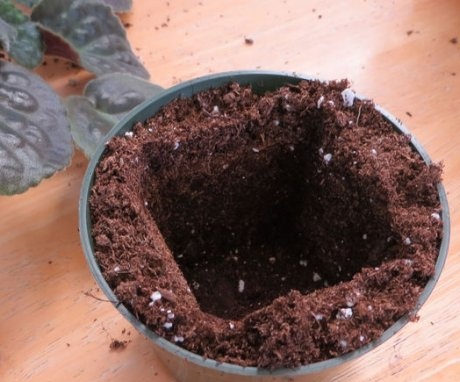
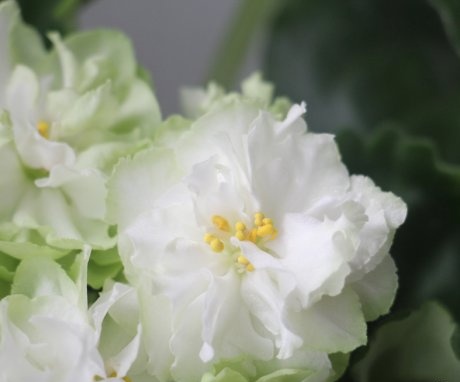

Recently I began to plant violets, this one, as I call it fluffy, Spring Rose is my favorite. But my friend put her eyes on her and asked to break off a piece of paper for her, I broke it off. And after that the violet stopped blooming, I don't know what to do now. I water it with fertilizers, I hope that my fluffy violet will recover soon and begin to bloom again.